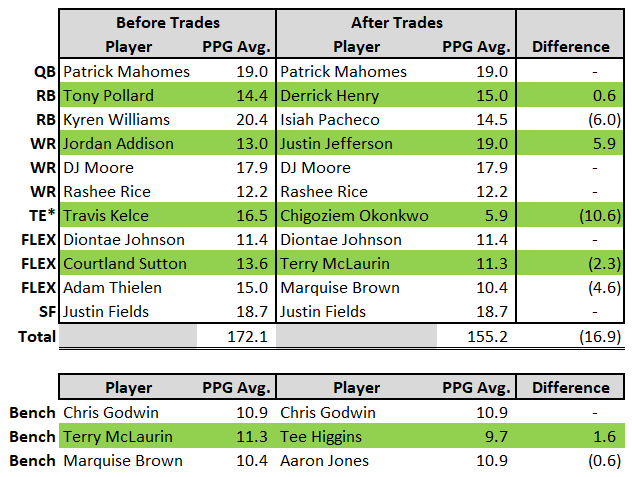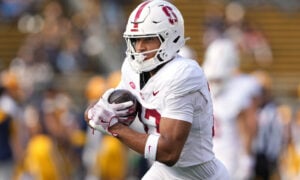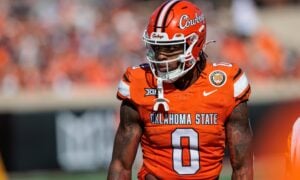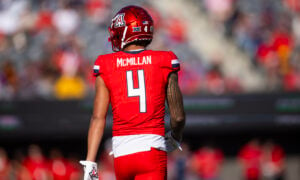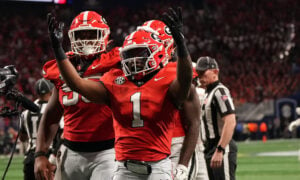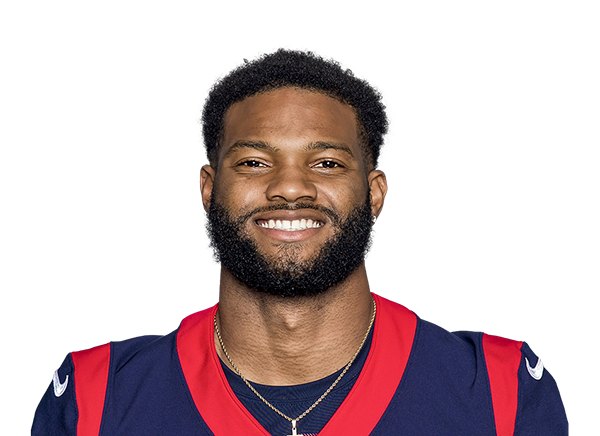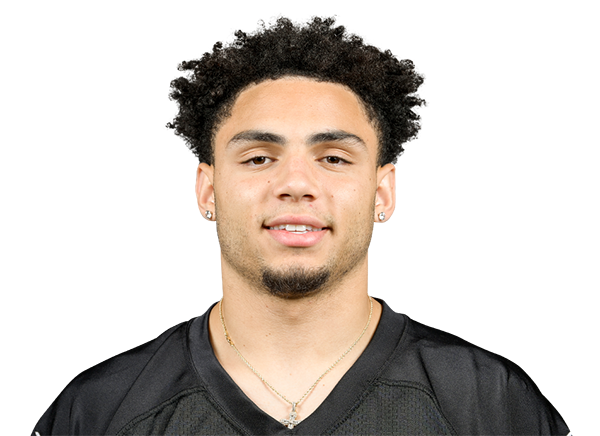Dynasty GAAP Memo: How to Turn a Pretender into a Contender
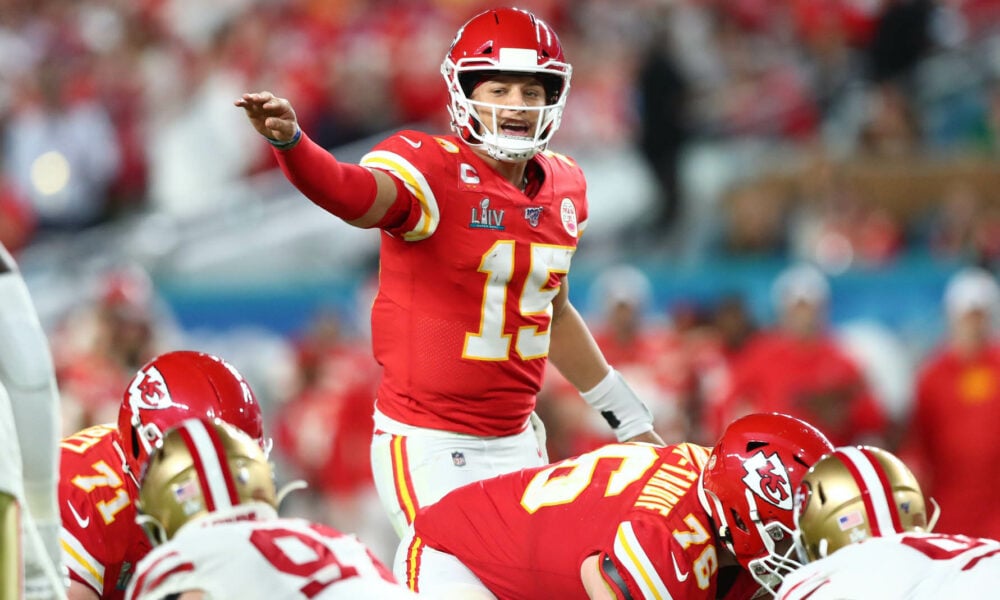
I am a CPA who fits the typical accountant stereotype. I enjoy writing technical accounting memos, accounting research (yes, it’s a thing), and analyzing the financial statements of a business. In accounting, you often must evaluate qualitative and quantitative factors during complex transactions to forecast future performance. I have found that the outlook and rationale of evaluating business transactions parallels another interest of mine, dynasty fantasy football.
In dynasty, we are given both quantitative factors (athletic scores, draft capital, college production, etc.) and qualitative factors (camp hype, team situation, injury history, etc.) that we must consider and evaluate to derive an estimate or projection of a player. Then, we must take calculated risks based on our team’s overall financial statements (i.e., current roster and league). I could go on and on with accounting-based puns and comparisons, but I think you get it.
I will note that I will write in the form of “accounting memos.” For anyone who has not been exposed, the format is very standard. Each memo will start with the “purpose.” Next, it will outline the applicable “guidance” or accounting literature utilized and supply background. Last will be the analysis and conclusion. The goal is to state the issue and quickly address it. My write-ups will follow this same logic.
To summarize, welcome to “Good at Analyzing Players” or “GAAP.” And yes, this is a play on “Generally Accepted Accounting Principles” and my wife did come up with it.
Purpose
The purpose of this memo is to introduce the “Pretender-Contender Retool” theory and discuss different ways to evaluate my recent dynasty trades utilizing business metrics as well as business theory.
Background
Over the last couple of weeks, I tried something new in one of my dynasty leagues, and it is what I like to call the ‘Pretender-Contender Retool’. The league is a ten-team superflex league and tight-end premium (1.5 PPR). Please see my starting lineup (and other flex options) prior to the trades below:
- QB – Patrick Mahomes, KC
- RB – Tony Pollard, DAL
- RB – Kyren Williams, LAR
- WR – DJ Moore, CHI
- WR – Jordan Addison, MIN
- WR – Rashee Rice, KC
- TE* – Travis Kelce, KC
- FLEX – Diontae Johnson, PIT
- FLEX – Courtland Sutton, DEN
- FLEX – Adam Thielen, MIN
- SF – Justin Fields, CHI
- Primary Bench Options:
- Chris Godwin, TB
- Terry McLaurin, WAS
- Marquise Brown, ARI
- Draft Picks: No first until 2027
As the playoffs inched closer and closer, I kept looking at this team and knew that I needed to make a move as I felt like more pretender than contender. Here are a few observations:
- My biggest strength is my QBs of Mahomes and Fields with the correlating stacks of Kelce and Moore, respectively.
- There is no elite upside at WR (besides underrated Moore and ascending Addison/Rice)
- I collected all underperforming 25 to 27-year-old WRs (Johnson, McLaurin, Brown, Godwin)
- It is paper thin at RB with questionable long-term options in Pollard (no contract, inefficient) and Williams (low draft capital)
- Not a lot of youth across the board
- Biggest Factor: Absolutely no draft capital with no firsts until 2027. This is what made this team complicated to evaluate and I knew I had to get creative.
At the time, I was third in the league at 8-4. In order to be successful in the playoffs (and in the future), I was going to need three weeks of luck in the playoffs to win.
This memo will explore the trades that I performed in the last two weeks and consider business metrics and business theory.
Resources:
- Sleeper: Great interface for looking up historical statistics
- DLF Dynasty Rankings: Best dynasty rankings in the industry
- DLF Average Draft Position (“ADP”) Data: Best resource to gauge current player value. Based on real dynasty startups.
Analysis
I want to introduce the concept of business metrics and the theory of business. Please see the definitions below:
- A business metric is a quantifiable measure businesses use to track, monitor and assess the success or failure of various business processes. The main point of using business metrics is to communicate an organization’s progress toward certain long- and short-term objectives.
- A business theory is the assumptions that shape any organization’s behavior, dictate its decisions about what to do and what not to do, and define what the organization considers meaningful results.
The business metric utilized will be 2023 average points per game from a quantitative perspective and the business theory (i.e., my thoughts or rationale) will assess from a qualitative perspective.
I will run through the trades performed in the last two weeks and outline the change in points per game, and my theory behind it.
Trade #1: Chiefs Infinity Stones (12/3/23)
After this trade, I had collected all of the marquee Chiefs players in Mahomes, Kelce, Rice and now Isiah Pacheco. However, the leaguemate who I traded with here was stacked at RB and this league is notorious for not paying for RBs (symptom of the position and being a 10-team). This was right after Mitchell had exploded for a couple of weeks. At the time, I was looking for another RB behind Williams and Pollard.
Objective: Aggregate upside and future draft capital to get a young ascending RB2.
Trade #2: WR > RB (12/7/23)
This trade hurts because I am a HUGE Williams fan and believe in the talent and this was my only share in the dynasty. However, my love for the longevity and stability of the WR position outweighed my love for 2023’s mini-Christian McCaffrey. The thought was that Tee Higgins will sign elsewhere after 2023 to be a team’s bonafide WR1 and hopefully gain an opportunity where he can amass 140+ targets per season (Panthers?). The WR1 upside he has flashed throughout his career should materialize. To the tune of > 20 PPR points per week? Probably not and especially not during 2023 with the Joe Burrow injury. However, I picked Williams off waivers this summer, so it felt like a ‘business exit’ point that I could live with.
Objective: Pivot from a low draft capital RB1 to a high-upside and young WR.
Trade #3: The End of Pollard’s Party (12/7/23)
Pollard has been successful from a fantasy perspective because of his elite snap share (71%) and opportunity share (67.7%) in 2023. However, he is approaching 27 years old, not as explosive, and does not have a long-term contract after the season. Based on his performance thus far, I would not be surprised if we compare 2024 Pollard to 2023 Miles Sanders. As someone holding a bunch of Sanders, I wanted off that train. As I mentioned above, this league also does not tend to value RBs and I had to jump at the opportunity to get a more liquid asset in the first-round rookie pick, even if it hurt my lineup.
Objective: Gain a more liquid asset (draft capital) to invest in a player that I liked more long-term. The pick lasted five days until….
Trade #4: JJ – All the Way! (12/12/23)
This obviously is the big one. Anytime you involve Justin Jefferson, you know there will be a high asking price. The idea here was that I needed an elite WR to pair with my existing core. A young WR core of Jefferson (24), DJ Moore (26), Tee Higgins (24), Rashee Rice (23), Marquise Brown (26), Chris Godwin (27), Diontae Johnson (27), and Terry McLaurin (28) can win a championship and keep me in the playoffs for the next two to three years. This is especially true if paired with Mahomes and Fields at superflex. I also backfilled the RB depth above with Derrick Henry but left a glaring hole on my roster at TE (only Chigoziem Okonkwo and Mike Gesicki left). Overall, my lineup got worse, but I think my team got better for longevity.
Objective: Gain a bonafide young WR1, whatever it costs.
Conclusion
What makes this exercise interesting is that from a business metric perspective, my lineup got worse on average by almost 17 points from week to week. See the summary below of before and after the trades:
From an overall business theory perspective, I am much happier with the makeup and longevity of my team. See my thoughts below player by player:
- QB: Patrick Mahomes – While 2023 is a down year, Mahomes is my QB1 in dynasty. He should be a QB1 for the next 5+ years.
- RB: Derrick Henry – I tend to think that Henry takes the Frank Gore career path and just continues to fall forward for > 4 yards per carry well into his 30s. He is just such an outlier at the position and is still averaging 4.09 YPC in 2023.
- RB: Isiah Pacheco – Pacheco was averaging a 74% snap share the two weeks prior to his injury. He is officially the bell cow we wanted Clyde Edwards-Helaire to be. At this point, I am not worried about the draft capital.
- WR: Justin Jefferson – 24-year-old first-ballot Hall of Famer. Count me in.
- WR: DJ Moore – Moore is going to finish as a WR1 with career bests in yards and TDs and still be outside the top-24 dynasty WRs. No one is talking about him, and I do not get it.
- WR: Rashee Rice – As a Chiefs fan, I watch a lot of Rice. He reminds me of Deebo Samuel in a lot of ways (big, fast, YAC ability, etc.). I am a believer that he will be a top 24 dynasty receiver soon (if he is not already).
- TE: Chigoziem Okonkwo – I like Okonkwo, but this needs to be fixed ASAP. Hopefully one of the WRs below will start producing again soon.
- WR: Diontae Johnson – There is upside in 2024 as I believe the Steelers QB1 is not currently on the roster.
- WR: Terry McLaurin – Always good, never great. I like McLaurin and, at 28, his age is making him a value.
- WR: Marquise Brown – Brown is a player I wrote about a couple of weeks ago as a buy. While he has not taken off like I thought he would with Kyler Murray’s return, there is still upside. He is a UFA after the season and could land in an ideal situation.
- SF: Justin Fields – I also wrote about Fields a couple of weeks ago. If he stays in Chicago? Great. If he moves on to Atlanta or the Steelers (both of which have been rumored)? Also, great.
- Bench: Chris Godwin – I do not watch enough TB games to know what is going on here. Is it a Baker Mayfield problem? Is it that Godwin cannot play outside and needs to move back to the slot? No idea, but I will bet on the 100-catch Godwin to rebound at some point.
- Bench: Tee Higgins – As discussed above, I bet he will be a Panther in 2024 and Bryce Young’s best friend.
- Bench: Aaron Jones – He needs to get healthy, stay healthy, and produce soon. Otherwise, I worry that Jones will be unemployed in 2024 at 30 years old.
Overall, I am not sure my team got better because of these moves, but it was a fun exercise to see how you can reallocate assets on a contender to achieve the portfolio and team makeup desired.
“Every champion was once a contender that refused to give up.”
- Dynasty GAAP Memo: Running Back Maturity Approach and Second-Year RBs - February 20, 2025
- Dynasty GAAP Memo: Post-Mortem Rookie Re-Draft - December 12, 2024
- Dynasty GAAP Memo: Buying The WR Dip Or Falling Knife? - November 14, 2024
I am a CPA who fits the typical accountant stereotype. I enjoy writing technical accounting memos, accounting research (yes, it’s a thing), and analyzing the financial statements of a business. In accounting, you often must evaluate qualitative and quantitative factors during complex transactions to forecast future performance. I have found that the outlook and rationale of evaluating business transactions parallels another interest of mine, dynasty fantasy football.
In dynasty, we are given both quantitative factors (athletic scores, draft capital, college production, etc.) and qualitative factors (camp hype, team situation, injury history, etc.) that we must consider and evaluate to derive an estimate or projection of a player. Then, we must take calculated risks based on our team’s overall financial statements (i.e., current roster and league). I could go on and on with accounting-based puns and comparisons, but I think you get it.
I will note that I will write in the form of “accounting memos.” For anyone who has not been exposed, the format is very standard. Each memo will start with the “purpose.” Next, it will outline the applicable “guidance” or accounting literature utilized and supply background. Last will be the analysis and conclusion. The goal is to state the issue and quickly address it. My write-ups will follow this same logic.
To summarize, welcome to “Good at Analyzing Players” or “GAAP.” And yes, this is a play on “Generally Accepted Accounting Principles” and my wife did come up with it.
Purpose
The purpose of this memo is to introduce the “Pretender-Contender Retool” theory and discuss different ways to evaluate my recent dynasty trades utilizing business metrics as well as business theory.
Background
Over the last couple of weeks, I tried something new in one of my dynasty leagues, and it is what I like to call the ‘Pretender-Contender Retool’. The league is a ten-team superflex league and tight-end premium (1.5 PPR). Please see my starting lineup (and other flex options) prior to the trades below:
- QB – Patrick Mahomes, KC
- RB – Tony Pollard, DAL
- RB – Kyren Williams, LAR
- WR – DJ Moore, CHI
- WR – Jordan Addison, MIN
- WR – Rashee Rice, KC
- TE* – Travis Kelce, KC
- FLEX – Diontae Johnson, PIT
- FLEX – Courtland Sutton, DEN
- FLEX – Adam Thielen, MIN
- SF – Justin Fields, CHI
- Primary Bench Options:
- Chris Godwin, TB
- Terry McLaurin, WAS
- Marquise Brown, ARI
- Draft Picks: No first until 2027
As the playoffs inched closer and closer, I kept looking at this team and knew that I needed to make a move as I felt like more pretender than contender. Here are a few observations:
- My biggest strength is my QBs of Mahomes and Fields with the correlating stacks of Kelce and Moore, respectively.
- There is no elite upside at WR (besides underrated Moore and ascending Addison/Rice)
- I collected all underperforming 25 to 27-year-old WRs (Johnson, McLaurin, Brown, Godwin)
- It is paper thin at RB with questionable long-term options in Pollard (no contract, inefficient) and Williams (low draft capital)
- Not a lot of youth across the board
- Biggest Factor: Absolutely no draft capital with no firsts until 2027. This is what made this team complicated to evaluate and I knew I had to get creative.
At the time, I was third in the league at 8-4. In order to be successful in the playoffs (and in the future), I was going to need three weeks of luck in the playoffs to win.
This memo will explore the trades that I performed in the last two weeks and consider business metrics and business theory.
Resources:
- Sleeper: Great interface for looking up historical statistics
- DLF Dynasty Rankings: Best dynasty rankings in the industry
- DLF Average Draft Position (“ADP”) Data: Best resource to gauge current player value. Based on real dynasty startups.
Analysis
I want to introduce the concept of business metrics and the theory of business. Please see the definitions below:
- A business metric is a quantifiable measure businesses use to track, monitor and assess the success or failure of various business processes. The main point of using business metrics is to communicate an organization’s progress toward certain long- and short-term objectives.
- A business theory is the assumptions that shape any organization’s behavior, dictate its decisions about what to do and what not to do, and define what the organization considers meaningful results.
The business metric utilized will be 2023 average points per game from a quantitative perspective and the business theory (i.e., my thoughts or rationale) will assess from a qualitative perspective.
I will run through the trades performed in the last two weeks and outline the change in points per game, and my theory behind it.
Trade #1: Chiefs Infinity Stones (12/3/23)
After this trade, I had collected all of the marquee Chiefs players in Mahomes, Kelce, Rice and now Isiah Pacheco. However, the leaguemate who I traded with here was stacked at RB and this league is notorious for not paying for RBs (symptom of the position and being a 10-team). This was right after Mitchell had exploded for a couple of weeks. At the time, I was looking for another RB behind Williams and Pollard.
Objective: Aggregate upside and future draft capital to get a young ascending RB2.
Trade #2: WR > RB (12/7/23)
This trade hurts because I am a HUGE Williams fan and believe in the talent and this was my only share in the dynasty. However, my love for the longevity and stability of the WR position outweighed my love for 2023’s mini-Christian McCaffrey. The thought was that Tee Higgins will sign elsewhere after 2023 to be a team’s bonafide WR1 and hopefully gain an opportunity where he can amass 140+ targets per season (Panthers?). The WR1 upside he has flashed throughout his career should materialize. To the tune of > 20 PPR points per week? Probably not and especially not during 2023 with the Joe Burrow injury. However, I picked Williams off waivers this summer, so it felt like a ‘business exit’ point that I could live with.
Objective: Pivot from a low draft capital RB1 to a high-upside and young WR.
Trade #3: The End of Pollard’s Party (12/7/23)
Pollard has been successful from a fantasy perspective because of his elite snap share (71%) and opportunity share (67.7%) in 2023. However, he is approaching 27 years old, not as explosive, and does not have a long-term contract after the season. Based on his performance thus far, I would not be surprised if we compare 2024 Pollard to 2023 Miles Sanders. As someone holding a bunch of Sanders, I wanted off that train. As I mentioned above, this league also does not tend to value RBs and I had to jump at the opportunity to get a more liquid asset in the first-round rookie pick, even if it hurt my lineup.
Objective: Gain a more liquid asset (draft capital) to invest in a player that I liked more long-term. The pick lasted five days until….
Trade #4: JJ – All the Way! (12/12/23)
This obviously is the big one. Anytime you involve Justin Jefferson, you know there will be a high asking price. The idea here was that I needed an elite WR to pair with my existing core. A young WR core of Jefferson (24), DJ Moore (26), Tee Higgins (24), Rashee Rice (23), Marquise Brown (26), Chris Godwin (27), Diontae Johnson (27), and Terry McLaurin (28) can win a championship and keep me in the playoffs for the next two to three years. This is especially true if paired with Mahomes and Fields at superflex. I also backfilled the RB depth above with Derrick Henry but left a glaring hole on my roster at TE (only Chigoziem Okonkwo and Mike Gesicki left). Overall, my lineup got worse, but I think my team got better for longevity.
Objective: Gain a bonafide young WR1, whatever it costs.
Conclusion
What makes this exercise interesting is that from a business metric perspective, my lineup got worse on average by almost 17 points from week to week. See the summary below of before and after the trades:
From an overall business theory perspective, I am much happier with the makeup and longevity of my team. See my thoughts below player by player:
- QB: Patrick Mahomes – While 2023 is a down year, Mahomes is my QB1 in dynasty. He should be a QB1 for the next 5+ years.
- RB: Derrick Henry – I tend to think that Henry takes the Frank Gore career path and just continues to fall forward for > 4 yards per carry well into his 30s. He is just such an outlier at the position and is still averaging 4.09 YPC in 2023.
- RB: Isiah Pacheco – Pacheco was averaging a 74% snap share the two weeks prior to his injury. He is officially the bell cow we wanted Clyde Edwards-Helaire to be. At this point, I am not worried about the draft capital.
- WR: Justin Jefferson – 24-year-old first-ballot Hall of Famer. Count me in.
- WR: DJ Moore – Moore is going to finish as a WR1 with career bests in yards and TDs and still be outside the top-24 dynasty WRs. No one is talking about him, and I do not get it.
- WR: Rashee Rice – As a Chiefs fan, I watch a lot of Rice. He reminds me of Deebo Samuel in a lot of ways (big, fast, YAC ability, etc.). I am a believer that he will be a top 24 dynasty receiver soon (if he is not already).
- TE: Chigoziem Okonkwo – I like Okonkwo, but this needs to be fixed ASAP. Hopefully one of the WRs below will start producing again soon.
- WR: Diontae Johnson – There is upside in 2024 as I believe the Steelers QB1 is not currently on the roster.
- WR: Terry McLaurin – Always good, never great. I like McLaurin and, at 28, his age is making him a value.
- WR: Marquise Brown – Brown is a player I wrote about a couple of weeks ago as a buy. While he has not taken off like I thought he would with Kyler Murray’s return, there is still upside. He is a UFA after the season and could land in an ideal situation.
- SF: Justin Fields – I also wrote about Fields a couple of weeks ago. If he stays in Chicago? Great. If he moves on to Atlanta or the Steelers (both of which have been rumored)? Also, great.
- Bench: Chris Godwin – I do not watch enough TB games to know what is going on here. Is it a Baker Mayfield problem? Is it that Godwin cannot play outside and needs to move back to the slot? No idea, but I will bet on the 100-catch Godwin to rebound at some point.
- Bench: Tee Higgins – As discussed above, I bet he will be a Panther in 2024 and Bryce Young’s best friend.
- Bench: Aaron Jones – He needs to get healthy, stay healthy, and produce soon. Otherwise, I worry that Jones will be unemployed in 2024 at 30 years old.
Overall, I am not sure my team got better because of these moves, but it was a fun exercise to see how you can reallocate assets on a contender to achieve the portfolio and team makeup desired.
“Every champion was once a contender that refused to give up.”
- Dynasty GAAP Memo: Running Back Maturity Approach and Second-Year RBs - February 20, 2025
- Dynasty GAAP Memo: Post-Mortem Rookie Re-Draft - December 12, 2024
- Dynasty GAAP Memo: Buying The WR Dip Or Falling Knife? - November 14, 2024








